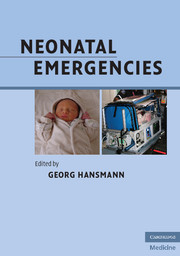Book contents
- Frontmatter
- Contents
- List of contributors
- Foreword (1)
- Foreword (2)
- Preface
- Acknowledgments
- Section 1 Organization of neonatal transport
- Section 2 Basics in cardiopulmonary resuscitation of newborn infants
- Section 3 Classic and rare scenarios in the neonatal period
- Section 4 Transport
- Section 5 Appendix
- Index
- Plate section
Foreword (1)
Published online by Cambridge University Press: 05 March 2012
- Frontmatter
- Contents
- List of contributors
- Foreword (1)
- Foreword (2)
- Preface
- Acknowledgments
- Section 1 Organization of neonatal transport
- Section 2 Basics in cardiopulmonary resuscitation of newborn infants
- Section 3 Classic and rare scenarios in the neonatal period
- Section 4 Transport
- Section 5 Appendix
- Index
- Plate section
Summary
In many ways neonatology is synonymous with emergency. Many of us in the field chose neonatology because of the potential for complex, medically and ethically challenging scenarios to arise anytime we are called to the delivery room and the opportunity to care for critically ill newborns while working under intense time pressure in the neonatal intensive care unit. Neonatal Emergencies, edited by Georg Hansmann, MD, PhD, is a welcome addition to our field of medicine. One of the most unique and valuable aspects of this text is its focus on emergency and critical care of the newborn. Unlike other textbooks of neonatology that attempt to cover all aspects of neonatal care, and because of this tend to become too unwieldy to serve as a source of rapidly accessible information, Neonatal Emergencies presents pertinent information in a concise, easy-to-read manner. Figures, tables, and algorithms convey information clearly and succinctly. There are many examples of practical advice for the health care professional at the bedside including topics such as what questions to ask when on the phone with a colleague who wishes to refer a patient to you for transport, and lists of appropriate procedures to perform, equipment to use, and medications to deliver when caring for a sick neonate. Key points are emphasized by positioning in a box where the text is preceded by an exclamation mark or is shaded.
- Type
- Chapter
- Information
- Neonatal Emergencies , pp. xiii - xivPublisher: Cambridge University PressPrint publication year: 2009



